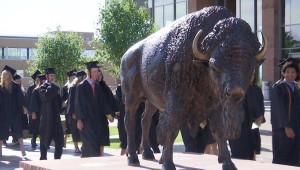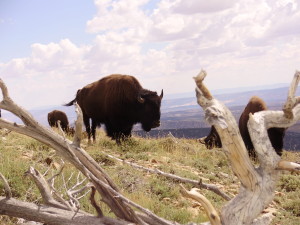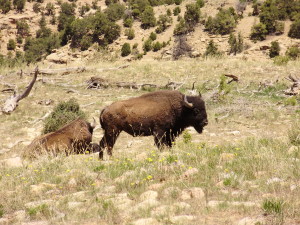ST. GEORGE – Last month, the American Bison was made the new mascot of Dixie State University to go along with its new Trailblazer motif. The beast has gone from being honored by a local university to being nationally recognized Monday as the United State’s official national mammal.

The “National Bison Legacy Act,” which gives the bison the national designation, was signed by President Barack Obama Monday.
Supporters of the legislation said they believe the recognition will elevate the stature of the bison to that of the bald eagle, long the national emblem, and bring greater attention to ongoing recovery efforts for the species.
“This majestic animal joins the ranks of the Bald Eagle as the official symbol of our country – and much like the eagle, it’s one of the greatest conservation success stories of all time,” the U.S. Department of the Interior stated on its website.
Lawmakers spearheading the effort said the once nearly extinct icon deserves the elevated stature because of its economic and cultural significance in the nation’s history.
“I hope that, in my lifetime, thanks to a broad coalition of ranchers, wildlife advocates and tribal nations, we will see bison return to the prominent place they once occupied in our nation’s shortgrass prairies,” said Democratic Sen. Martin Heinrich, of New Mexico, who worked with Republican Sen. John Hoeven, of North Dakota, to pass the Senate version of the legislation.
An estimated 30-75 million bison roamed North America until European settlers moved west and hunted the herds into the late 1800s, according to the U.S. Fish and Wildlife Service. By the mid-1880s, it was estimated that only around 325 bison were left in the entire country.

“Conservation of the buffalo came slowly,” according the U.S. Fish and Wildlife Service. “In May 1894, Congress enacted a law making buffalo hunting in Yellowstone National Park illegal. Eight years later, money was appropriated to purchase 21 buffalo from private herds to build up the Yellowstone herd.”
Today, there are 17 federally-managed bison herds across the country that include approximately 10,000 bison. The Yellowstone National Park herd, perhaps one the best known in the country, has an estimated population of 4,900, according to the Interior Department.
Overall, an estimated 500,000 now live in the U.S., though the majority are not considered genetically-pure. Many have been crossbred with cattle and are semidomesticated. About 30,000 wild bison roam the country.
One of the genetically-pure herds is found in the Henry Mountains of Garfield County. The original herd – about 20 bison – was transplanted to Utah from the Yellowstone herd in the 1940s.

The story of the bison is not complete without mentioning the significance the animals held for many Native American tribes. The tribes relied on the bison for food and used their hides for clothing. The animals also held a special spiritual significance to the tribes as well.
“The American buffalo, also known as bison, has always held great meaning for American Indian people,” according to the InterTribal Buffalo Council. “To Indian people, buffalo represent their spirit and remind them of how their lives were once lived, free and in harmony with nature.”
According to U.S. Fish and Wildlife Service, it was believed by many of the day that the eradication of the bison would help destroy the livelihood and well-being of the Native American tribes who relied on the animal. As such, it is believed this way of thinking played a part in the bisons’ near-annihilation.
The InterTribal Buffalo Council is a part of the Vote Bison Coalition, which successfully lobbied to have the animal proclaimed the official mammal of the United States.
“The adoption of bison as our National Mammal represents a validation of the many meaningful ways this animal represents America,” John Calvelli, Wildlife Conversation Society executive vice president for public affairs, said in a press release. “As an ecological keystone, cultural bedrock and economic driver, the bison conveys values such as unity, resilience and commitment to healthy landscapes and communities.”
The Associated Press contributed to this article.
Resources
- PDF: The National Bison Legacy Act
- Dept. of the Interior: 15 Facts About Our National Mammal: The American Bison
Email: [email protected]
Twitter: @MoriKessler
Copyright St. George News, SaintGeorgeUtah.com LLC, 2016, all rights reserved.
And why not the human being as the national mammal?
Animals are more important than people